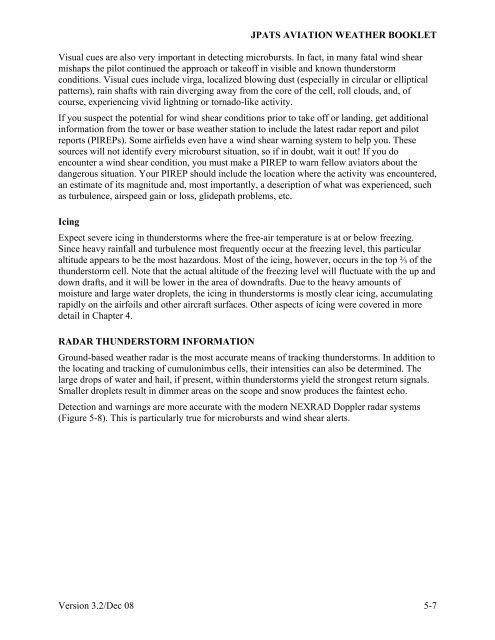JPATS Weather - NETC
JPATS Weather - NETC
JPATS Weather - NETC
Create successful ePaper yourself
Turn your PDF publications into a flip-book with our unique Google optimized e-Paper software.
<strong>JPATS</strong> AVIATION WEATHER BOOKLET<br />
Visual cues are also very important in detecting microbursts. In fact, in many fatal wind shear<br />
mishaps the pilot continued the approach or takeoff in visible and known thunderstorm<br />
conditions. Visual cues include virga, localized blowing dust (especially in circular or elliptical<br />
patterns), rain shafts with rain diverging away from the core of the cell, roll clouds, and, of<br />
course, experiencing vivid lightning or tornado-like activity.<br />
If you suspect the potential for wind shear conditions prior to take off or landing, get additional<br />
information from the tower or base weather station to include the latest radar report and pilot<br />
reports (PIREPs). Some airfields even have a wind shear warning system to help you. These<br />
sources will not identify every microburst situation, so if in doubt, wait it out! If you do<br />
encounter a wind shear condition, you must make a PIREP to warn fellow aviators about the<br />
dangerous situation. Your PIREP should include the location where the activity was encountered,<br />
an estimate of its magnitude and, most importantly, a description of what was experienced, such<br />
as turbulence, airspeed gain or loss, glidepath problems, etc.<br />
Icing<br />
Expect severe icing in thunderstorms where the free-air temperature is at or below freezing.<br />
Since heavy rainfall and turbulence most frequently occur at the freezing level, this particular<br />
altitude appears to be the most hazardous. Most of the icing, however, occurs in the top ⅔ of the<br />
thunderstorm cell. Note that the actual altitude of the freezing level will fluctuate with the up and<br />
down drafts, and it will be lower in the area of downdrafts. Due to the heavy amounts of<br />
moisture and large water droplets, the icing in thunderstorms is mostly clear icing, accumulating<br />
rapidly on the airfoils and other aircraft surfaces. Other aspects of icing were covered in more<br />
detail in Chapter 4.<br />
RADAR THUNDERSTORM INFORMATION<br />
Ground-based weather radar is the most accurate means of tracking thunderstorms. In addition to<br />
the locating and tracking of cumulonimbus cells, their intensities can also be determined. The<br />
large drops of water and hail, if present, within thunderstorms yield the strongest return signals.<br />
Smaller droplets result in dimmer areas on the scope and snow produces the faintest echo.<br />
Detection and warnings are more accurate with the modern NEXRAD Doppler radar systems<br />
(Figure 5-8). This is particularly true for microbursts and wind shear alerts.<br />
Version 3.2/Dec 08 5-7









